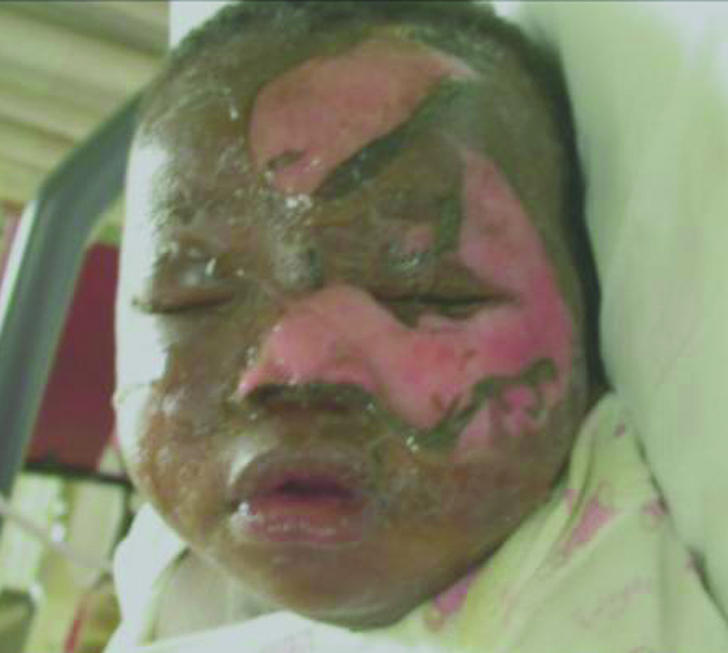Steam inhalation is a common home remedy for infections of the upper respiratory tract. Between 1 July and 31 December 2002 seven children were admitted to the burns unit of a children's hospital in Dublin with scalds sustained during the course of such treatment.
Cases
We saw seven children over six months who had sustained scalds directly associated with steam inhalation. The children ranged in age from nine months to 10 years. The scalding ranged in extent from 3% to 6% of the total body surface area. Six children sustained burns to the face after direct contact with steam or hot water. Two children had burns caused by the bowl of water spilling on to their chest or lap. Four children will have permanent scarring, although only one required a skin graft. All of the burns were sufficient to cause extensive blistering (partial thickness or second degree). None of the children needed fluid resuscitation or intervention to protect the airway. These children represented 9% of all children admitted with burns or scalds during the six months and accounted for 78 inpatient days. The parents of two of the children spontaneously reported that their general practitioner had recommended steam inhalation as a treatment.
Discussion
Although steam inhalation is commonly recommended as a treatment for infection of the upper respiratory tract in children, the evidence that it has any beneficial effect on the course of the illness is limited. A Cochrane review of the use of heated humidified air for the common cold concluded that although there was evidence that symptoms were relieved, there was no objective improvement in outcome measures such as viral shedding or viral titres in nasal washings.1 The trials included in this review involved the use of a rhinotherm device. A rhinotherm is a system that delivers hot humidified air at a set temperature to the nasal mucosa and raises its temperature. The air is delivered by nasal prongs. The common technique of steam inhalation, in which the head is held under a towel over a bowl of very hot water to which a nasal decongestant may be added, carries a substantial risk of scalding or even direct steam burns. The risk of injury must be greater for young children who do not understand what is happening and who cannot explain that the steam may be burning their face.
Figure 1.

Facial scalding from steam inhalation
Other preventable domestic injuries resulting in scalds in children have been reported, highlighting the hazards of common practices in the home. Jeffery and colleagues reported scalds in 23 children sustained after they knocked or pulled over jugs or bowls of hot water that were being used to heat bottles of milk.2 Two cases of burns in children who were treated for inflammation of the upper respiratory tract by inhalation of steam from camomile tea have been reported.3 However, to our knowledge no reports have been made of scalds from direct contact with steam or hot water used to treat a cold.
Quite apart from the immediate pain and suffering, these injuries may cause permanent disfigurement and contractures that worsen with growth. On rare occasions, even small scalds can be fatal if complicated by staphylococcal toxic shock syndrome.
We would recommend that if steam inhalation is to be used for the relief of symptoms healthcare professionals must be explicit about its mode of delivery. Modell and colleagues advise parents to “sit in the bathroom with a hot shower running, the child on their lap, being read a story.”4 Techniques involving kettles or bowls of boiling water should be actively discouraged, because of the dangers shown in this report.
Advise parents how to administer steam inhalation to children to avoid scalding
Contributors: SMM, DM, and DJAO were involved in managing the patients and noticed the trend in patients. SS provided input from the general practitioner's perspective. All authors were involved in writing the paper. SM is the guarantor.
Funding: None.
Competing interests: None declared.
References
- 1.Singh M. Heated, humidified air for the common cold. Cochrane Database Syst Rev 2001;(4): CD001728. [DOI] [PubMed]
- 2.Jeffery SLA, Cubison TCS, Greenaway C, Gilbert PM, Parkhouse N. Warming milk—a preventable cause of scalds in children. BMJ 2000;320: 235. [DOI] [PMC free article] [PubMed] [Google Scholar]
- 3.Balslev T, Moller AB. [Burns in children caused by camomile tea]. Ugeskr Laeger 1990;152: 1384. (In Danish.) [PubMed] [Google Scholar]
- 4.Modell M, Mughal Z, Boyd R. Paediatric problems in general practice. 3rd ed. Oxford: Oxford University Press, 1996: 199.


